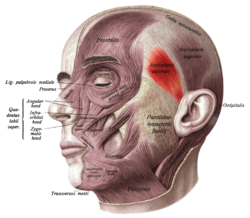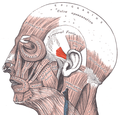|
Anterior auricular muscle
The anterior auricular muscle, the smallest of the three auricular muscles, is thin and fan-shaped, and its fibers are pale and indistinct. It arises from the lateral edge of the epicranial aponeurosis, and its fibers converge to be inserted into a projection on the front of the helix. StructureThe anterior auricular muscle arises from the lateral edge of the epicranial aponeurosis.[1] It inserts into a projection on the front of the helix.[1] Nerve supplyThe anterior auricular muscle is supplied is supplied by the temporal branch of the facial nerve (VII).[2][3] It may also receive some small branches from the auriculotemporal nerve, a branch of the mandibular nerve, itself a branch of the trigeminal nerve (V).[4] RelationsThe anterior auricular muscle is the smallest of the three auricular muscles.[1] The superficial temporal artery, a branch of the external carotid artery, travels underneath the anterior auricular muscle to supply the auricle of the outer ear.[1] FunctionThe anterior auricular muscle draws the auricle of the outer ear upwards and forwards.[1] This is a very subtle movement in most people, although some people can wiggle their ears.[1] See alsoAdditional images
References
Wikimedia Commons has media related to Auricularis anterior muscles. |
||||||||||||||||||||||||||||||


